 Browns Archive
Browns Archive  Browns Game Vault: 12/17/50. Middle Guard Bill Willis Helps Ensure NFL Title Game Berth
Browns Game Vault: 12/17/50. Middle Guard Bill Willis Helps Ensure NFL Title Game Berth
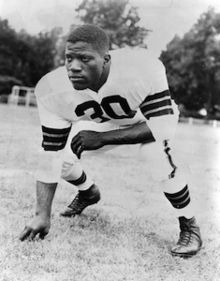 In a way, it’s not fair. When one reviews the career of a sports icon who helped break the color barrier in American society, the temptation is to focus on his race, and the life and times in which he lived. This is natural; that was the tense and dangerous crucible in which he displayed honor and dignity.
In a way, it’s not fair. When one reviews the career of a sports icon who helped break the color barrier in American society, the temptation is to focus on his race, and the life and times in which he lived. This is natural; that was the tense and dangerous crucible in which he displayed honor and dignity.
Such grace and courage define him, and they are a credit to him. But does he get credit for his talent, and his will to succeed? Those traits define him as well. Typically, of course, the pioneers of racial integration in the 1940s were required to possess equal, heaping measures of athletic skills and content of character.
When WWII ended, Paul Brown was released from his commission at the Great Lakes Naval Base, on Lake Michigan north of Chicago. He looked to return to his dream job, as head coach of The Ohio State Buckeyes. Unfortunately for Brown, he was embroiled in a puzzling power struggle with the school’s athletic director, Lynn St. John. St. John ‘won’ when he was unable to match the generous salary offer by the owner of the newly-formed pro football franchise in Cleveland, Mickey McBride. Ohio State’s passing on Brown ran counter to the wishes of the Ohio high school football coaches, the press, and alumni.
McBride didn’t know much about football, but he was determined to run his new team as a first class operation. Among top coaching candidates, he’d only really heard of Notre Dame coach Frank Leahy. He made Leahy a nice offer, and it was accepted. The university pleaded with McBride to leave their coach alone; he agreed, in part because he had two boys enrolled there at the time and wanted to spare them any possible unease from hard feelings. The owner was subsequently advised by a sports reporter to pursue Paul Brown.
Brown’s cornerstone- the first player he acquired- was QB Otto Graham out of Northwestern. Graham had won the enduring admiration of the coach from their days in the Big Ten Conference. Brown began recruiting several of the Buckeye players he’d coached in college, including Lou Groza, Dante Lavelli, and Lin Houston. (This infuriated the natives of Columbus. These players had college eligibility remaining, and Brown had always been opposed to college players going pro prior to graduating. But these were now grown men returning from the theatres of war in Europe and the Pacific, not your typical college boys.)
A key piece on the Ohio State defense was middle guard Bill Willis. Willis graduated in 1945 (he volunteered to join the Army but was ruled ineligible due to varicose veins), and coached at a small college in Kentucky for a year. There had been no black professional football players since the early 1930s, the result of an unspoken ban by the NFL. The All America Football Conference (AAFC), the new league in which the Cleveland franchise would be a charter member, had announced they had “no rule that bars a Negro athlete from playing.”
The time was ripe for racial integration in pro sports. Black baseball players commonly barnstormed with professional ballplayers, and they played with and 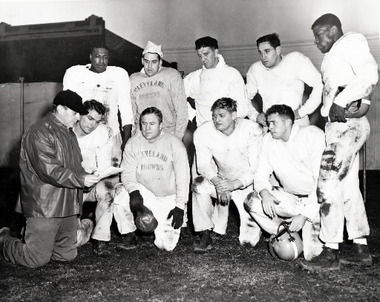 against each other in the Puerto Rican winter league. That league actually began to muster a challenge to Major League Baseball by attempting to lure ballplayers of all races to its summer rosters. Boxing, second in popularity to the national pastime, had been a proving ground for black men such as Joe Louis, “The Brown Bomber”. And, much of college football was well integrated (the Big Ten certainly was).
against each other in the Puerto Rican winter league. That league actually began to muster a challenge to Major League Baseball by attempting to lure ballplayers of all races to its summer rosters. Boxing, second in popularity to the national pastime, had been a proving ground for black men such as Joe Louis, “The Brown Bomber”. And, much of college football was well integrated (the Big Ten certainly was).
Willis called Paul Brown for a tryout. Brown’s interest was outwardly tepid, at best. Taking that as a rejection, Willis made arrangements to join the Montreal Alouettes of the Canadian Football League. Before he could finalize those plans, a football writer convinced him to attend the already-begun Cleveland football camp, at Bowling Green University. When he arrived, Paul Brown acted as though he’d been expecting Willis to report. One may surmise that here was an example of Brown pulling strings behind the scenes. Some feel the coach used this process as a way of easing Willis into the fold without drawing more public attention to his race than was necessary.
It is well accepted that racial integration was among the litany of innovations that Paul Brown introduced to professional football. Most historians do not consider this to be born of a moral crusade; rather, they take Brown at his word: he wanted the very best football players he could find. Still, there was an element of courage involved in featuring fine black athletes- remember, this was 1946, and the debut of baseball’s Jackie Robinson and Larry Doby was still a year away.
(Photo above, from the Plain Dealer: "In an early 1950s photo, (bottom, left to right) Browns' coach Paul Brown, Dante Lavelli, Lin Houston, Frank Gatski and George Young, and (standing, left to right) Marion Motley, Otto Graham, Mac Speedie, Lou Groza and Bill Willis.")
Many Cleveland Browns fans can tell the legendary story of Bill Willis’ first practice with the Cleveland team (they had yet to be named). Willis lined up over the center, Mo Scarry. Each time the ball was snapped, Willis penetrated the backfield. Scarry complained that he was jumping offside. Brown studied each snap intently, and no - Willis was simply that quick. He jumped when the center’s fingers moved for the snap. Once, he was able to lunge and grab hold of Otto Graham’s belt before the quarterback could drop back. This led to another of Paul Brown’s innovations: have the quarterback stand behind the center with one foot behind the other, instead of parallel to the line. That way, he could push off and drop back more quickly.
Most of the team accepted Willis and the man brought in to be his roommate, fullback Marion Motley. There was a rumble of discontent among some, however, and this was summarily quashed by Brown. And if they didn’t know already, Brown made it clear to the two black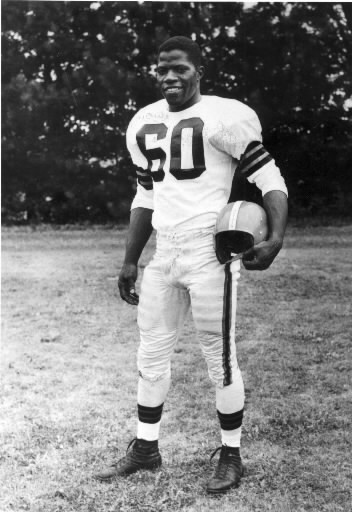 players that opposing teams and crowds would try their best to make life tough for them. There was name calling and attempts to pick fights through brutal cheap shots. The two were asked by restaurant and motel owners to leave their premises (Brown stood up for them and leveraged the team’s patronage against those who would enforce segregation). There was the infamous episode of the two black players being left behind, rather than make a trip to segregationist Miami. Not disclosed at the time was the death threat sent to Motley if he crossed the goal line.
players that opposing teams and crowds would try their best to make life tough for them. There was name calling and attempts to pick fights through brutal cheap shots. The two were asked by restaurant and motel owners to leave their premises (Brown stood up for them and leveraged the team’s patronage against those who would enforce segregation). There was the infamous episode of the two black players being left behind, rather than make a trip to segregationist Miami. Not disclosed at the time was the death threat sent to Motley if he crossed the goal line.
Bill Willis was a force on the Cleveland defense. He was the ‘middle guard’, playing over the offensive center in a 5-man front line. At 6’2” and between 199 and 210 pounds, he was a bit small even for his time. But Willis revolutionized the position. His job was to play side-to-side, to play the sweep and short passes. From his days as a Buckeye, however, he was used to applying pressure in the backfield; Paul Brown could see that he was fast enough to provide penetration while still honoring his horizontal responsibilities (his speed was such that Brown sometimes had him sprint with the running backs, probably to embarrass some of them). The role that Willis grew into was the precursor of the middle linebacker of present-day 4-3 defenses.
The Cleveland Browns dominated the AAFC from 1946 through 1949. They were one of three teams from that league to join the rival NFL in 1950. This was the Browns’ opportunity to demonstrate that they truly were among the best teams in football. For their opening game, the league pitted the Browns against the defending champion Philadelphia Eagles, in Philly. Most NFL observers assumed the Eagles would crush the Browns. Instead, it was Cleveland in a blowout. The Browns were relentless in their vertical passing game.
After the contest, the Philadelphia coach was still not convinced. Sure, Cleveland won with ‘finesse’, as he portrayed it, but such passing was a fad that would not last in the NFL for long. So when the Eagles visited Cleveland for the rematch later that season, the Browns ran the ball on every offensive play from scrimmage. They did not throw one pass the entire day. The Browns won, 13-7.
The New York Giants represented the only bump in the road for the Browns. They beat Cleveland twice during the regular season, 6-0 and 17-13, using an “umbrella defense” (a ‘6-1-2-2’) designed specifically to thwart the Browns’ offense. The Giants and the Browns both ended the regular season at 10-2, so they staged a special playoff game to see who would play in the 1950 NFL title game.
In the pivotal playoff game, the Cleveland Browns solved the Giants’ defense. (Normally, I scoff when I hear how one team cannot beat another three times in one season. If one team is better than the other, they can. But in this case, three games were enough for the Browns to figure out how to attack the Giants.) In front of 33,000 frigid fans at Cleveland Stadium, the recurring chant that day actually was “hold that line” (that strikes me as extremely quaint, as does the Plain Dealer game story, which declared that on this day, “professional football at last (came) of age in Cleveland”). On day when the field was frozen solid, both teams famously wore sneakers. The stars of the game for Cleveland were Otto Graham and Lou Groza.
And, on a day when the entire defense was stellar, Bill Willis. In the second half, the Giants moved the ball some on the Browns, and were also pushed back on several plays. Halfback Gene “Choo Choo” Roberts asserted himself in the fourth quarter. Roberts had had success running around right end, and was threatening to score on such a play from the Browns’ 36, with the game on the line. Out of nowhere came Bill Willis, who pulled Roberts down at the 4. On the next two plays, fullback Eddie Price was sent up the middle, and was stopped cold by Willis both times. The Giants threw for a touchdown on the next play- but the Giants were penalized 5 yards instead, for offensive offside. From the Browns’ 8, the Giants passed again… and the Browns’ Tommy James picked off the pass. Unfortunately, the Browns were called for defensive holding. First down, Giants.
Price ran for a yard to the 3, before the Giants suffered another 5 yard penalty. They tried sending running back Joe Scott around the right side. But Bill Willis, who also had an earlier tackle for a safety to his credit, broke into the backfield and dropped Scott for a 5 yard loss. The Giants were held to a field goal, and the Cleveland Browns were on their way to the win.
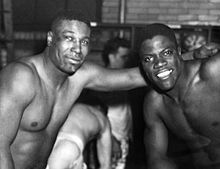
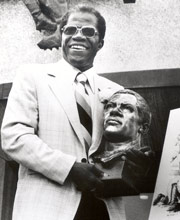 They would square off against the Los Angeles (formerly Cleveland) Rams in the title game. The Browns would find themselves trailing the Rams by 8 in the fourth quarter, only to rise to the occasion as they had all season. They were champions of the doubting NFL, in their first season.
They would square off against the Los Angeles (formerly Cleveland) Rams in the title game. The Browns would find themselves trailing the Rams by 8 in the fourth quarter, only to rise to the occasion as they had all season. They were champions of the doubting NFL, in their first season.
Bill Willis, along with Marion Motley (photo of both at right), retired in 1954. He had been the Browns’ best player on a fine defense, an all-pro in each of the 8 seasons he played. He fit the Paul Brown mold of fast and smart, vs. size alone.
Willis was popular in both Columbus and Cleveland, and he used his notoriety to help at-risk youth upon his retirement. He was elected to the College Football Hall of Fame in 1971, and to the Pro Football Hall of Fame in 1977. He is a member of the Ring of Honor for the Cleveland Browns, and his number 99 is retired by The Ohio State Buckeyes.
He was among a special breed of pioneers. He was athletically skilled, yet able to thrive amid intense, undeserved adversity.
Thank you for reading. Sources included Paul Brown, the Rise and Fall and Rise Again of Football’s Most Innovative Coach, Andrew O’Toole; Tales from the Browns’ Sideline, Tony Grossi; the Cleveland Browns website’s history page for 1950, Steve King; the Browns game story database on Cleveland.com; the Pro Football Hall of Fame website; Wikipedia.
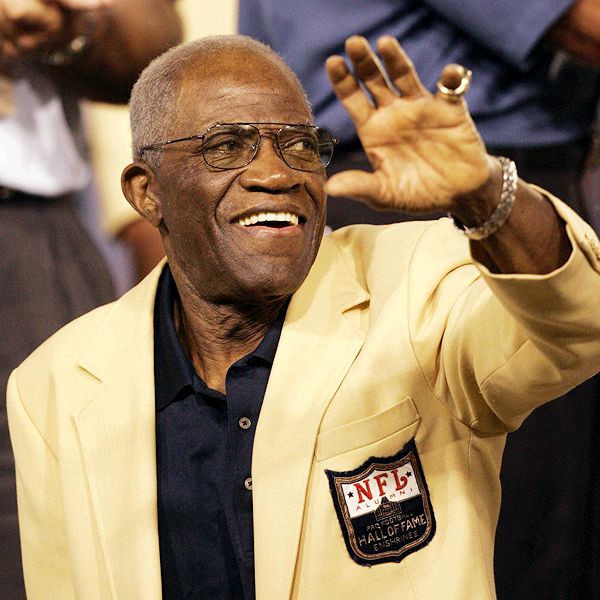
- NBA Announces 2013-2014 Schedule
- Browns Ink Sharknado
- Sharknado A No-Show For Rookie Camp
- Trent Richardson Out Until Training Camp
- Browns Sign Brandon Jackson
- Carrasco Suspended Eight Games
- Browns Add to Wide Receiver Depth with David Nelson
- Browns Need to Learn from Past Draft Mistakes
- Browns Release Chris Gocong and Usama Young
- Browns Missing on Grimes Disappointing, But Not The End
The TCF Forums
- Official- Browns Coach Search/Rumors
mattvan1 (Tuesday, January 21 2014 1:19 PM) - Movies coming out
rebelwithoutaclue (Tuesday, January 21 2014 12:56 PM) - 2015 Recruiting
jclvd_23 (Tuesday, January 21 2014 12:38 PM) - The 2014 Offseason Thread
Larvell Blanks (Tuesday, January 21 2014 12:25 PM) - Chris Grant's first 3 drafts
Kingpin74 (Tuesday, January 21 2014 10:13 AM) - Mike Brown
YahooFanChicago (Monday, January 20 2014 11:15 PM) - 2014 Hoops Hockey Hijinx
jpd1224 (Monday, January 20 2014 4:44 PM) - 2014 Recruiting
jclvd_23 (Monday, January 20 2014 2:26 PM) - Wish List - #4 Pick
Hikohadon (Monday, January 20 2014 1:26 PM) - #1 overall pick Anthony Bennett
TouchEmAllTime (Sunday, January 19 2014 1:28 PM)



